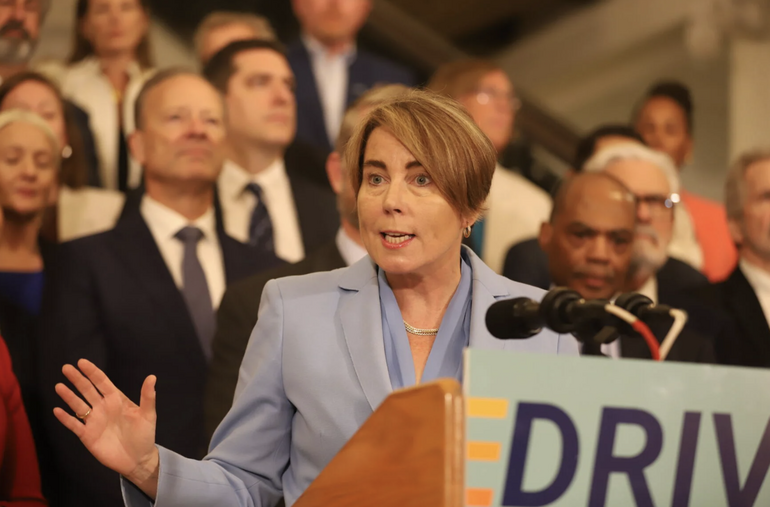Gov. Maura Healey wants to infuse the state’s research and jobs sector with hundreds of millions of dollars as Massachusetts grapples with a tight fiscal climate and federal fluctuations in research and education support.
Flanked by cabinet secretaries and life sciences, academic, labor and business leaders, Healey on Thursday announced she’s filing a $400 million bill “to leverage private and institutional resources” to retain and create jobs, support research and protect innovation. The proposal (HD 4990) is one piece of a new plan the administration has dubbed the “Discovery, Research and Innovation for a Vibrant Economy” (DRIVE) initiative.
“This isn’t just about filling gaps left by federal cuts. This is forward-looking,” Healey said when rolling out the initiative at a press conference. “In this moment, with uncertainty in Washington, in the face of competition from places like China, we are stepping forward, Massachusetts, to lead.”
Touting it as “something that no other state is doing,” Healey said the initiative would not just create jobs in health care, education and science sectors, but also in retail, food services, legal, construction and manufacturing.
The state lost 1,900 payroll jobs in June, according to the most recent data. June unemployment in Massachusetts remained flat at about 4.8%, while the national unemployment rate dropped to 4.1%. The Healey administration has notably changed the way it presents jobs data in recent months.
Healey’s office cited a July 2025 report by the UMass Donahue Institute’s Economic and Public Policy Research Group which found that 81,300 jobs, $7.8 billion of income and more than $16 billion in economic activity are generated and supported by the $8.57 billion in annual federal research and development funding provided to Massachusetts.
“We are deeply concerned that recently, the federal policy that is being established is not forward-thinking,” Boston Children’s Hospital CEO Kevin Churchwell said Thursday. “We’re experiencing the cuts that everyone else is experiencing, the delays and, most importantly, the unpredictability that threatens our global science leadership.”
About $200 million of Healey’s $400 million proposal would go to a one-time multi-year research funding pool, based at MassDevelopment, to support research projects at hospitals, universities and independent research institutions. The state would support the fund by using the interest generated from its stabilization fund, which as of June 2025 had a balance of $8.1 billion.
The other $200 million would be placed into a higher education bridge funding reserve, funded by the income surtax paid by wealthier households. Meant to provide public higher education campuses with support for “direct and indirect costs of research, cross-regional partnerships and joint ventures,” according to Healey’s office, the reserve would also put funding toward preserving and hiring positions in research and teaching.
According to a July 16 report from the independent database Grant Witness, which tracks National Institutes of Health and National Science Foundation grant terminations across the country, Massachusetts institutions have lost more than $1.2 billion in funding this year — funding that was awarded but not paid out due to terminations. The database reports that nearly 700 grants in Massachusetts are currently terminated.
The proposal “will be a lifeline to our private universities and public research universities and hospitals,” UMass President Marty Meehan said Thursday.
UMass Chan Medical School has seen 70 NIH grants, worth more than $42 million, terminated by the federal government, according to Meehan. The UMass system is already seeing its post-doctoral and research faculty be recruited by other countries, he added.
“I’ve talked to the presidents of public and private research universities across this country, in both red and blue states, and what Governor Healey is proposing is a national model for all states where research is critical to the economy,” Meehan said.
Massachusetts received $22.9 billion in total federal funding in 2024, according to a state funding dashboard. State programs have lost $714 million in federal funding cuts this year, including $14.2 million to economic development, $118.4 million to health and human services, $121 million to education funds and $327 million to transportation, according to the dashboard.
Massachusetts’ fiscal 2026 budget relies on nearly $16 billion in federal funding, according to a report by Massachusetts Taxpayers Foundation.
Healey’s proposal would also authorize the transfer of additional resources from the pool of federal match funds to the Health Safety Net Trust Fund. The state’s Health Safety Net pays acute care hospitals and community health centers for some essential health care services provided to those who are uninsured and underinsured.
In addition to filing a bill, Healey will create a “Research Catalyst Fund” to accept and distribute philanthropic contributions and matching funds from the industry, according to her office. Those funds will be governed by a new Research Opportunity Review Board.
Healey also will sign an executive order creating an Advisory Commission on Advancing Research and Discovery in Massachusetts — a group meant to recommend solutions to “strengthen the research and innovation ecosystem and advance scientific discovery and job creation.” The commission will include medical, higher education and economic development sector leaders, per the administration.
Healey filed the bill late Thursday afternoon.
States are grappling with the economic impacts of President Donald Trump’s shifting tariff and trade policies, which Massachusetts officials have said could dramatically increase the costs of imports needed for things like housing construction. In a more than 200,000-unit housing deficit, the state is attempting over many years to gradually increase housing production. On Thursday, Healey announced $182 million in tax credits and subsidies that her administration said will create at least 1,245 affordable housing units.
According to a Wednesday report from the U.S. Bureau of Economic Analysis, gross domestic product (GDP), a broad measure of U.S. economic activity, increased at an annual rate of 3% in the second quarter of 2025. U.S. GDOP decreased .5% in the first quarter of 2025, the first time the GDP decreased in three years.

